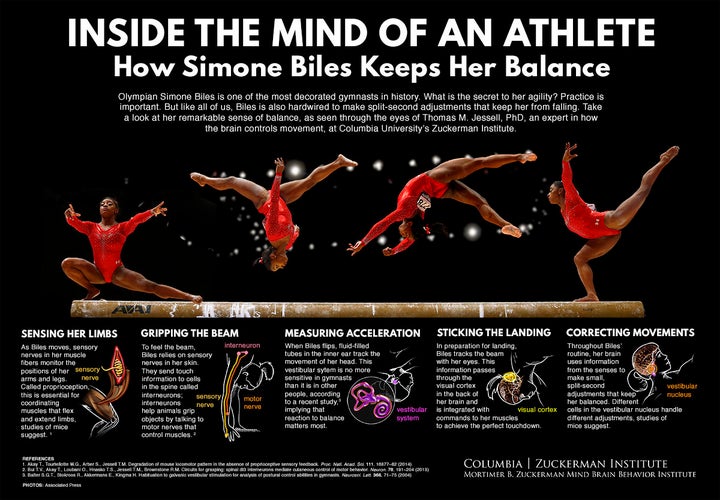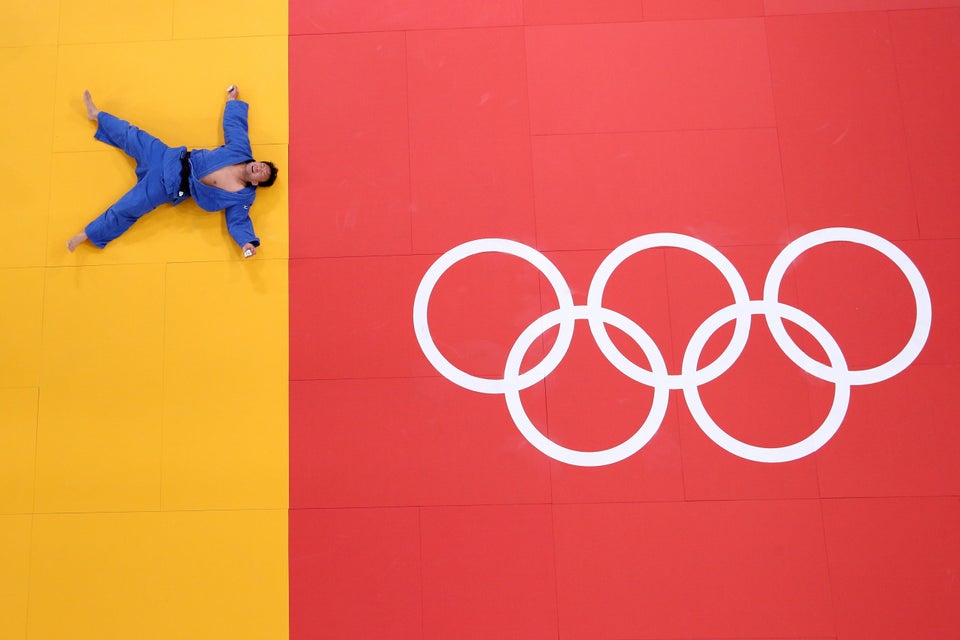
Team USA gymnast Simone Biles twists and flips through air with a seemingly gravity-defying buoyancy. With great precision, she lands on the balance beam as if the 4-inch-wide ledge is an extension of her own body.
As the 19-year-old gymnast competes in the Olympics in Rio de Janeiro this week, pulling out the types of combinations that have been repeatedly called “impossible,” you may ask what it is exactly that sets her apart — is it only practice? Or does Biles have a particular brain wiring that’s given her a repertoire of movements far beyond a human’s humble ability to walk straight and a traditional gymnast’s perfect 10?
Scientists haven’t looked into Bile’s brain, but if they were given the chance, they wouldn’t even necessarily know which area to peek at first.
“It’s a difficult question,” said Thomas Jessell, co-director of Columbia University’s Mortimer B. Zuckerman Mind Brain Behavior Institute and a neuroscientist who has studied movement for over three decades. Understanding how someone like Biles acquires her athletic skills is “an issue where no one bit of the brain or the spinal cord is going to give you the definitive answer.”
The closest idea we have as to what makes someone a super-athlete like Michael Jordan or Biles is that they may have been born with a slightly better-wired motor system.
“It could be that the wiring that happened in early development was particularly precise,” Jessell said. “So you have the opportunity to refine and perform motor tasks more effectively.”

The motor system in the brain is mysterious and complex. Nevertheless, over the past few decades, neuroscience has made advances in deciphering how a 3-pound organ controls hundreds of muscles in the body.
Even a simple movement ― say, taking one single step ― requires the orchestrated work of many parts of the brain. Simply put, when you decide to move a limb, neurons in the primary motor cortex of the brain devise a plan. This plan involves commands to multiple muscles that need to flex or extend to carry out the desired movement. The command signals pass through other brain areas, which refine the plan by amping the necessary signals and shutting down the noise. The signals are then sent down through the spinal cord to reach the muscles. Jessell’s own research has revealed how young cells grow into the type of neurons that contribute to movement in the spinal cord.
There are probably at least a million cells just in the primary motor cortex that are communicating with the spinal cord. The activity of those cells is controlled by many tens of millions of nerve cells elsewhere in the brain. “We get to very big numbers very quickly,” Jessell said.
Add to this complex picture the numerous other brain mechanisms that sense where the body is in space at any given time and work to keep it from falling down. (For an overview, check out the infographic above.)
Luckily, we don’t need to understand this complex system in order to put one foot in front of the other. What’s more, this intricate system learns pretty well (for example, think about how babies start by chaotically throwing their arms around but eventually learn to hold their head up and stand straight).
With rigorous training, most people can push the normal set of everyday movements further and learn to do the flips that Biles does. “But they’d do it a hell of a lot less well,” Jessell said.
Some researchers have attempted to see how the brain’s structure and function may change as a result of gymnastics training. In a series of experiments, researchers at South China Normal University scanned the brains of world class gymnasts and found that the nerve connections between the cortex and the spinal cord were stronger in gymnasts compared with non-gymnasts. They also found increased connectivity in the brain regions responsible for sensory and motor functions, as well as attentional systems. Moreover, the brains of the champions appeared to have greater efficiency in several brain regions that correspond to motor and attention functions.
“Our study indicates that neuroanatomical adaptations ... occur in gymnasts’ brain anatomical networks either in response to long-term intensive gymnastic training or as an innate predisposition or both,” the researchers wrote in their study published in NeuroImage in 2013.
These neuroanataomical adaptations are what scientists call brain plasticity—that is, the brain’s ability to learn by rearranging its own wiring and fortifying some connections throughout practice.
While all brains are good at learning, it’s possible that some brains are more plastic than others. In other words, what sets super-athletes apart may be their brain’s enhanced learning ability. If that’s the case for the brain of someone like Biles, it means her motor system responds to physical practice even better than what’s normally expected.
To really understand what’s happening inside the brain of an extraordinary gymnast like Biles, we may need new technology to see the brain in action, Jessell said. “There have been remarkable advances in the last two decades in the technology for monitoring nerve cells while they’re functioning. But we need to go much further.”

